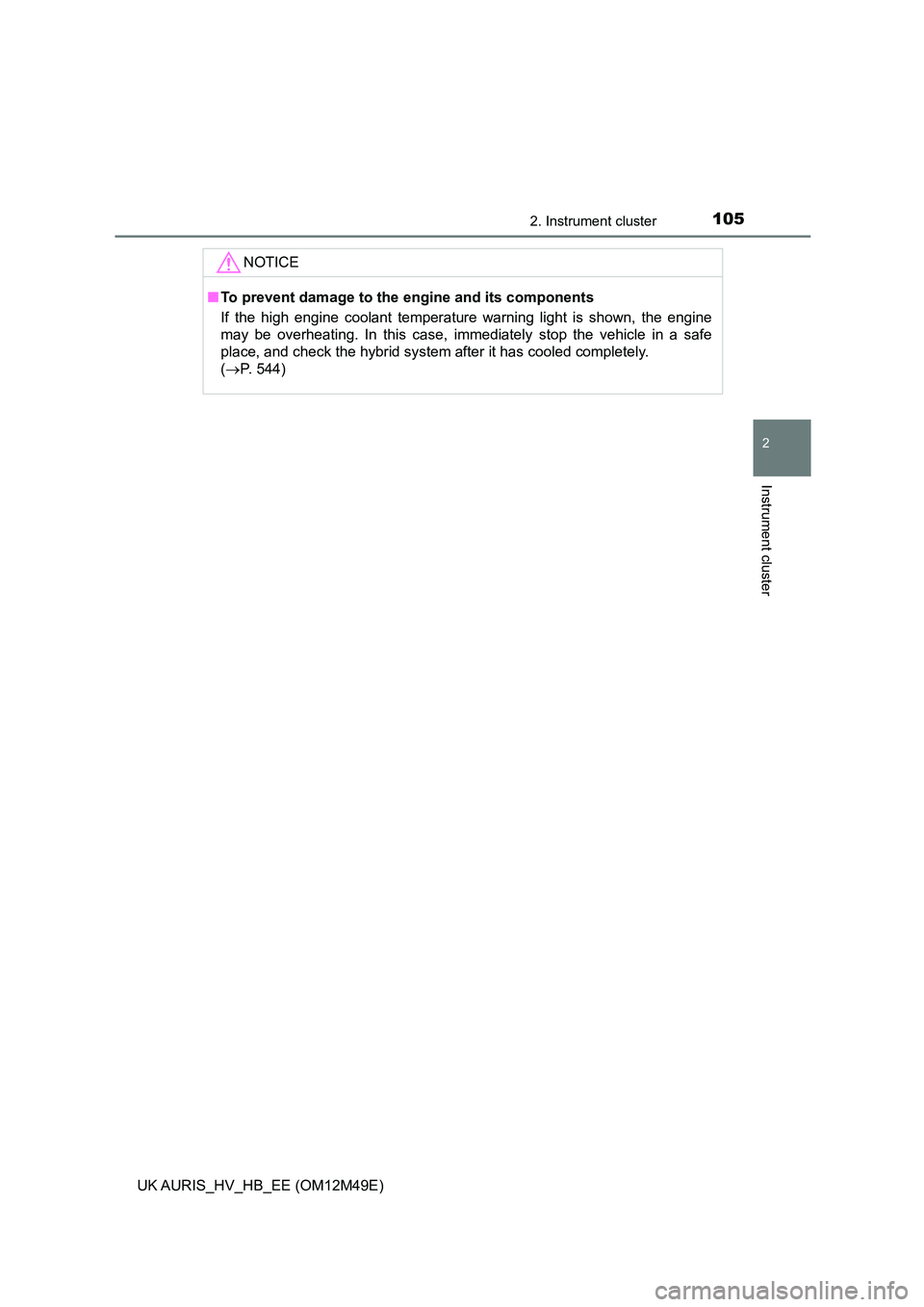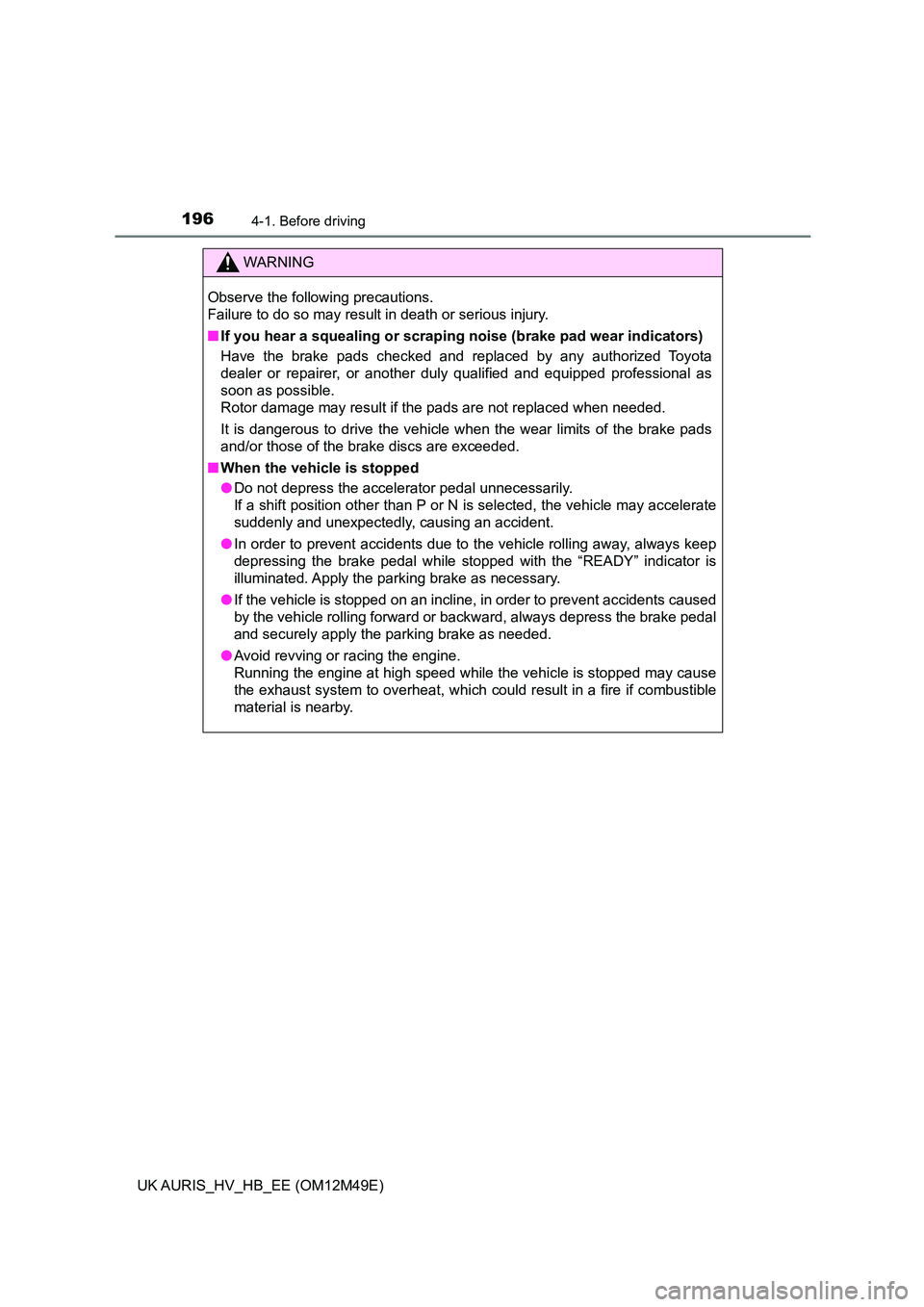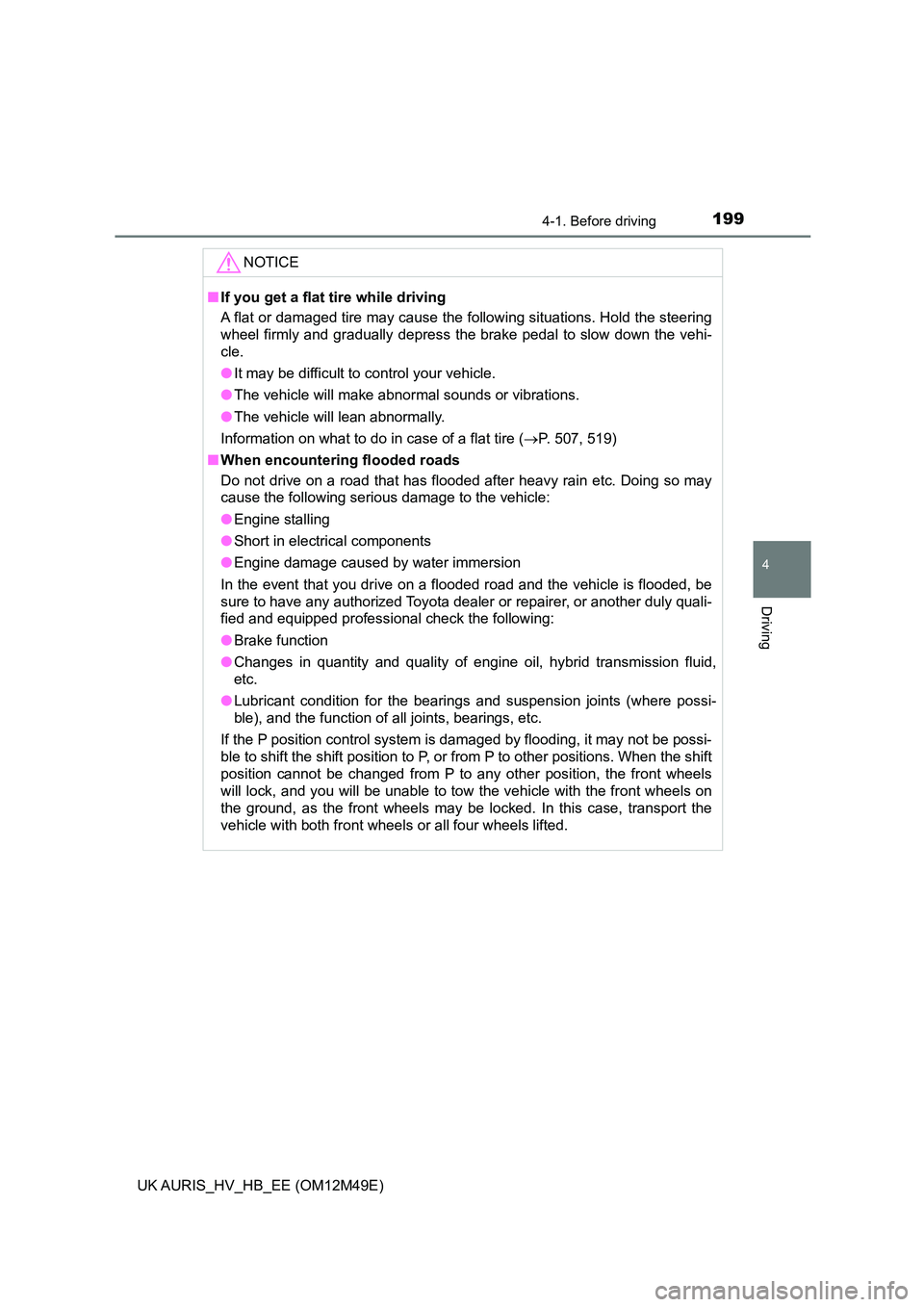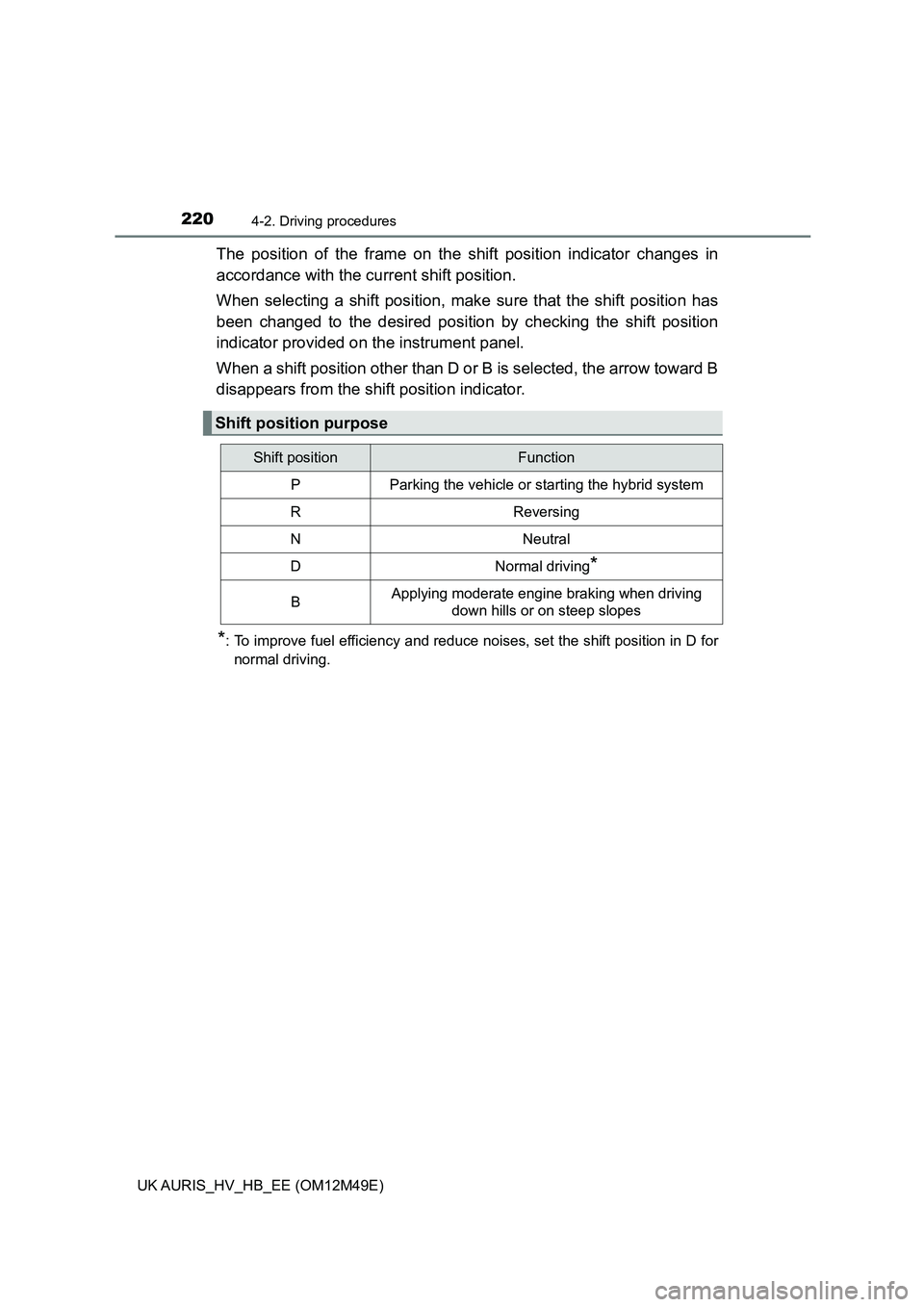check engine TOYOTA AURIS 2018 Owners Manual (in English)
[x] Cancel search | Manufacturer: TOYOTA, Model Year: 2018, Model line: AURIS, Model: TOYOTA AURIS 2018Pages: 592, PDF Size: 28.6 MB
Page 6 of 592

TABLE OF CONTENTS6
UK AURIS_HV_HB_EE (OM12M49E)
7-1. Maintenance and care
Cleaning and protecting
the vehicle exterior ..........412
Cleaning and protecting
the vehicle interior ...........416
7-2. Maintenance
Maintenance
requirements....................419
7-3. Do-it-yourself
maintenance
Do-it-yourself service
precautions ......................422
Hood ..................................424
Positioning a floor jack .......426
Engine compartment..........427
12-volt battery ....................434
Tires ...................................439
Tire inflation pressure ........453
Wheels ...............................455
Air conditioning filter ..........457
Electronic key battery ........459
Checking and replacing
fuses ................................462
Light bulbs .........................467
8-1. Essential information
Emergency flashers .......... 482
If your vehicle has
to be stopped
in an emergency ............. 483
8-2. Steps to take
in an emergency
If your vehicle needs
to be towed ..................... 484
If you think something
is wrong........................... 490
If a warning light turns on
or a warning buzzer
sounds ............................ 491
If a warning message
is displayed ..................... 498
If you have a flat tire
(vehicles with
a spare tire) ..................... 507
If you have a flat tire
(vehicles with
an emergency tire
puncture repair kit) .......... 519
If the hybrid system will
not start ........................... 534
If the electronic key
does not operate
properly ........................... 536
If the 12-volt battery
is discharged ................... 539
If your vehicle
overheats ........................ 544
If the vehicle becomes
stuck................................ 549
7Maintenance and care8When trouble arises
Page 15 of 592

15Pictorial index
UK AURIS_HV_HB_EE (OM12M49E)
Windshield wipers . . . . . . . . . . . . . . . . . . . . . . . . . . . . . . . . . P. 237
Precautions for winter . . . . . . . . . . . . . . . . . . . . . . . . . . . . . . . P. 314
Precautions for using a car wash . . . . . . . . . . . . . . . . . . . . . . P. 414
Fuel filler door . . . . . . . . . . . . . . . . . . . . . . . . . . . . . . . . . . . . P. 243
Refueling method . . . . . . . . . . . . . . . . . . . . . . . . . . . . . . . . . . P. 243
Fuel type/fuel tank capacity . . . . . . . . . . . . . . . . . . . . . . . . . . . P. 554
Tires . . . . . . . . . . . . . . . . . . . . . . . . . . . . . . . . . . . . . . . . . . . . P. 439
Tire size/inflation pressure . . . . . . . . . . . . . . . . . . . . . . . . . . . . P. 560
Winter tires/tire chains . . . . . . . . . . . . . . . . . . . . . . . . . . . . . . . P. 314
Checking/rotation/tire pressure warning system*1 . . . . . . . . . P. 439
Coping with flat tires . . . . . . . . . . . . . . . . . . . . . . . . . . . . . . . . P. 507
Hood . . . . . . . . . . . . . . . . . . . . . . . . . . . . . . . . . . . . . . . . . . . . P. 424
Opening . . . . . . . . . . . . . . . . . . . . . . . . . . . . . . . . . . . . . . . . . . P. 424
Engine oil . . . . . . . . . . . . . . . . . . . . . . . . . . . . . . . . . . . . . . . . . P. 555
Coping with overheating . . . . . . . . . . . . . . . . . . . . . . . . . . . . . P. 544
Headlights/front position lig hts/daytime running lights/
turn signal lights . . . . . . . . . . . . . . . . . . . . . . . . . . . . . . P. 227, 229
Front fog lights*1. . . . . . . . . . . . . . . . . . . . . . . . . . . . . . . . . . P. 235
Stop lights/tail lights/turn signal lights . . . . . . . . . . . . P. 227, 229
License plate lights . . . . . . . . . . . . . . . . . . . . . . . . . . . . . . . . P. 229
Tail lights . . . . . . . . . . . . . . . . . . . . . . . . . . . . . . . . . . . . . . . . P. 229
Rear fog light*3 . . . . . . . . . . . . . . . . . . . . . . . . . . . . . . . . . . . P. 235
Back-up light*2
Shifting the shift position to R . . . . . . . . . . . . . . . . . . . . . . . . . P. 219
Tail lights . . . . . . . . . . . . . . . . . . . . . . . . . . . . . . . . . . . . . . . . P. 229
Rear fog light*2 . . . . . . . . . . . . . . . . . . . . . . . . . . . . . . . . . . . P. 235
Back-up light*3
Shifting the shift position to R . . . . . . . . . . . . . . . . . . . . . . . . . P. 219
4
5
6
7
Light bulbs of the ext erior lights for driving
(Replacing method: P. 467, Watts: P. 563)
8
9
10
11
12
13
*1: If equipped
*2: Left-hand drive vehicles
*3: Right-hand drive vehicles
Page 105 of 592

1052. Instrument cluster
UK AURIS_HV_HB_EE (OM12M49E)
2
Instrument cluster
NOTICE
■To prevent damage to the engine and its components
If the high engine coolant temperature warning light is shown, the engine
may be overheating. In this case, immediately stop the vehicle in a safe
place, and check the hybrid system after it has cooled completely.
( P. 544)
Page 194 of 592

1944-1. Before driving
UK AURIS_HV_HB_EE (OM12M49E)
WARNING
Observe the following precautions.
Failure to do so may result in death or serious injury.
■ When driving the vehicle
● During normal driving, do not turn off the hybrid system. Turning the hybrid
system off while driving will not cause loss of steering or braking control,
but the power assist to these systems will be lost. This will make it more
difficult to steer and brake, so you should pull over and stop the vehicle as
soon as it is safe to do so.
However, in the event of an emergency, such as if it becomes impossible
to stop the vehicle in the normal way: P. 483
● Use engine braking (shift position B) to maintain a safe speed when driv-
ing down a steep hill.
Using the brakes continuously may cause the brakes to overheat and lose
effectiveness. ( P. 219)
● Do not adjust the positions of the steering wheel, the seat, or the inside or
outside rear view mirrors while driving.
Doing so may result in a loss of vehicle control.
● Always check that all passengers’ arms, heads or other parts of their body
are not outside the vehicle.
Page 195 of 592

1954-1. Before driving
UK AURIS_HV_HB_EE (OM12M49E)
4
Driving
WARNING
Observe the following precautions.
Failure to do so may result in death or serious injury.
■ When driving on slippery road surfaces
● Sudden braking, acceleration and steering may cause tire slippage and
reduce your ability to control the vehicle.
● Sudden acceleration, engine braking due to shifting, or changes in engine
speed could cause the vehicle to skid.
● After driving through a puddle, lightly depress the brake pedal to make
sure that the brakes are functioning properly. Wet brake pads may prevent
the brakes from functioning properly. If the brakes on only one side are wet
and not functioning properly, steering control may be affected.
■ When changing the shift position
● Do not let the vehicle roll backwards while a forward driving position is
selected, or roll forward while R is selected.
Doing so result in an accident or damage to the vehicle.
● Do not shift the shift position to P while the vehicle is moving.
Doing so can damage the transmission and may result in a loss of vehicle
control.
● Do not shift the shift position to R while the vehicle is moving forward.
Doing so can damage the transmission and may result in a loss of vehicle
control.
● Do not shift the shift position to a driving position while the vehicle is mov-
ing backward.
Doing so can damage the transmission and may result in a loss of vehicle
control.
● Shifting the shift position to N while the vehicle is moving will disengage
the hybrid system. Engine braking is not available with the hybrid system
disengaged.
● Be careful not to change the shift position with the accelerator pedal
depressed.
Changing the shift position to any position other than P or N may lead to
unexpected rapid acceleration of the vehicle that may cause an accident
and result in death or serious injury.
After changing the shift position, make sure to check the current shift posi-
tion using the shift position indicator. ( P. 219)
Page 196 of 592

1964-1. Before driving
UK AURIS_HV_HB_EE (OM12M49E)
WARNING
Observe the following precautions.
Failure to do so may result in death or serious injury.
■ If you hear a squealing or scraping noise (brake pad wear indicators)
Have the brake pads checked and replaced by any authorized Toyota
dealer or repairer, or another duly qualified and equipped professional as
soon as possible.
Rotor damage may result if the pads are not replaced when needed.
It is dangerous to drive the vehicle when the wear limits of the brake pads
and/or those of the brake discs are exceeded.
■ When the vehicle is stopped
● Do not depress the accelerator pedal unnecessarily.
If a shift position other than P or N is selected, the vehicle may accelerate
suddenly and unexpectedly, causing an accident.
● In order to prevent accidents due to the vehicle rolling away, always keep
depressing the brake pedal while stopped with the “READY” indicator is
illuminated. Apply the parking brake as necessary.
● If the vehicle is stopped on an incline, in order to prevent accidents caused
by the vehicle rolling forward or backward, always depress the brake pedal
and securely apply the parking brake as needed.
● Avoid revving or racing the engine.
Running the engine at high speed while the vehicle is stopped may cause
the exhaust system to overheat, which could result in a fire if combustible
material is nearby.
Page 199 of 592

1994-1. Before driving
UK AURIS_HV_HB_EE (OM12M49E)
4
Driving
NOTICE
■If you get a flat tire while driving
A flat or damaged tire may cause the following situations. Hold the steering
wheel firmly and gradually depress the brake pedal to slow down the vehi-
cle.
● It may be difficult to control your vehicle.
● The vehicle will make abnormal sounds or vibrations.
● The vehicle will lean abnormally.
Information on what to do in case of a flat tire ( P. 507, 519)
■ When encountering flooded roads
Do not drive on a road that has flooded after heavy rain etc. Doing so may
cause the following serious damage to the vehicle:
● Engine stalling
● Short in electrical components
● Engine damage caused by water immersion
In the event that you drive on a flooded road and the vehicle is flooded, be
sure to have any authorized Toyota dealer or repairer, or another duly quali-
fied and equipped professional check the following:
● Brake function
● Changes in quantity and quality of engine oil, hybrid transmission fluid,
etc.
● Lubricant condition for the bearings and suspension joints (where possi-
ble), and the function of all joints, bearings, etc.
If the P position control system is damaged by flooding, it may not be possi-
ble to shift the shift position to P, or from P to other positions. When the shift
position cannot be changed from P to any other position, the front wheels
will lock, and you will be unable to tow the vehicle with the front wheels on
the ground, as the front wheels may be locked. In this case, transport the
vehicle with both front wheels or all four wheels lifted.
Page 209 of 592

2094-1. Before driving
UK AURIS_HV_HB_EE (OM12M49E)
4
Driving
■Sudden acceleration/steering input/cornering
Executing sharp turns when towing ma y result in the trailer colliding
with your vehicle. Decelerate well in advance when approaching
turns and take them slowly and carefully to avoid sudden braking.
■Important points regarding turning
The wheels of the trailer will travel closer to the inside of the curve
than the wheels of the vehicle. To make allowance for this, take the
turns wider than you would normally do.
■Important points regarding stability
Vehicle movement resulting from uneven road surfaces and strong
crosswinds will affect handling. The vehicle may also be rocked by
passing buses or large trucks. Frequently check behind when mov-
ing alongside such vehicles. As soon as such vehicle movement
occurs, immediately start to decel erate smoothly by slowly applying
the brakes. Always steer the vehi cle straight ahead while braking.
■Passing other vehicles
Consider the total combined length of your vehicle and trailer and
ensure that the vehicle-to-vehicle distance is sufficient before exe-
cuting lane changes.
■Transmission information
To maintain engine braking effi ciency and charging system perfor-
mance when using engine braking, do not use the transmission in
D. Shift the shift position to B.
■If the engine overheats
Towing a loaded trailer up a long, steep incline in temperatures
exceeding 30 C (85F) may result in the engine overheating. If the
engine coolant temperature gauge indi cates that the engine is over-
heating, turn the air conditioning off immediately, leave the road and
stop the vehicle in a safe place. ( P. 544)
■When parking the vehicle
Always place wheel chocks under the wheels of both the vehicle
and trailer. Firmly set the parking brake and shift the shift position to
P.
Page 220 of 592

2204-2. Driving procedures
UK AURIS_HV_HB_EE (OM12M49E)
The position of the frame on the shift position indicator changes in
accordance with the current shift position.
When selecting a shift position, make sure that the shift position has
been changed to the desired position by checking the shift position
indicator provided on the instrument panel.
When a shift position other than D or B is selected, the arrow toward B
disappears from the shift position indicator.
*: To improve fuel efficiency and reduce noises, set the shift position in D for
normal driving.
Shift position purpose
Shift positionFunction
PParking the vehicle or starting the hybrid system
RReversing
NNeutral
DNormal driving*
BApplying moderate engine braking when driving
down hills or on steep slopes
Page 314 of 592

3144-7. Driving tips
UK AURIS_HV_HB_EE (OM12M49E)
●Use fluids that are appropriate to the prevailing outside tempera-
tures.
• Engine oil
• Engine/power control unit coolant
• Washer fluid
● Have a service technician inspect the condition of the 12-volt bat-
tery.
● Have the vehicle fitted with four snow tires or purchase a set of tire
chains for the front tires.
Ensure that all tires are the same size and brand, and that chains match
the size of the tires.
Perform the following accordin g to the driving conditions:
● Do not try to forcibly open a window or move a wiper that is frozen.
Pour warm water over the frozen area to melt the ice. Wipe away
the water immediately to prevent it from freezing.
● To ensure proper operation of the climate control system fan,
remove any snow that has accumu lated on the air inlet vents in
front of the windshield.
● Check for and remove any excess ice or snow that may have accu-
mulated on the exterior lights, vehicle’s roof, chassis, around the
tires or on the brakes.
● Remove any snow or mud from the bottom of your shoes before
getting in the vehicle.
Winter driving tips
Carry out the necessary preparations and inspections before
driving the vehicle in winter. Al ways drive the vehicle in a man-
ner appropriate to the prevailing weather conditions.
Preparation for winter
Before driving the vehicle